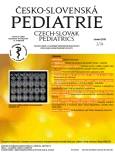Fibromuscular dysplasia in a 2 years old child – casuistics
Authors:
J. Surgošová 1; M. Kolníková 1; Ľ. Podracká 2; T. Dallos 2; S. Jakešová 3; P. Talarčík 4
Authors‘ workplace:
Klinika detskej neurológie LFUK, NÚDCH, Bratislava, Slovensko
1; Pediatrická klinika LFUK, NÚDCH, Bratislava, Slovensko
2; Rádiologické oddelenie NÚDCH, Bratislava, Slovensko
3; Cythopatos, s. r. o., Bratislava, Slovensko
4
Published in:
Čes-slov Pediat 2019; 74 (3): 161-167.
Category:
Overview
Fibromuscular dysplasia is an idiopathic, non-inflammatory disease of small and middle-sized arteries at which the focal rebuilding of vessel walls eventuates into their stenoses, oclusias, dissections or aneurysms. The disease may affect virtually every arterial basin. In adult population it occurs mostly in the group of young females and affects mostly the renal basin.
The authors present a case of a child with serious perinatal anamnesis that developed a clinical appearance of quickly progressing ischemic affected CNS. It was accompanied by uncorrectable hypertension, stenotic affection of renal, carotidal and vertebral basin and very probably splanchnic and extremital arteries. The disease of the child had malign course and ended fatally. That is not typical in adult population, however it occurs in child population.
In adult population it is a rare, nevertheless well described disease. The rareness and specifics of the disease in kids might point to it being a separate unit despite identical histopathological findings.
Keywords:
fibromuscular dysplasia – ischemic stroke – arterial stenosis – hypertension – string of beads – cutis marmorata – hemihypotrophy
Sources
1. Slovut DP, Olin JW. Fibromuscular dysplasia. N Engl J Med 2004; 350: 1982–1971.
2. Touze E, Oppemheim C, Trystram D, et al. Fibromuscular dyspalsia of cervical and intracranial arteries. Int J Stroke 2010; 5: 296–305.
3. Green R, Gu X, Kline-Rogers E, et al. Differences between the pediatric and adult presentation of fibromuscular dysplasia: results from US Registry. Pediatr Nephrol 2015 April; 14. doi 10.1007/s00467-015-3234-z.
4. Kirton A, Crone M, Benseler S, et al. Fibromuscular dysplasia and childhood stroke. Brain 2013; 136 (6): 1846–1856.
5. Plouin PF, Perdu J, La Batide-Alanore A, et al. Fibromuscular dysplasia. Orphanet J Rare Dis 2007; 2: 28.
6. Tsioufis C, Andrikou I, Siasos G, et al. Anti-hypertensive treatment in periferal artery dinase. Current Opinion in Pharmacology April 2018; 39: 35–42. https://doi.org/10.1016/j.coph.2018.01.009
7. Cragg AH, Smith TP, Thompson BH, et al. Incidental fibromuscular dysplasia in potential renal donors: long-term clinical follow-up. Radiology 1989; 172: 145–147.
8. Olin JW, Froehlich J, Gu X, et al. The United States Registry for Fibromuscular Dysplasia: results in the first 447 patients. Circulation 2012; 125: 3182–3190.
9. Perdu J, Boutouyrie P, Bourgain C, et al. Inheritance of arterial lesions in renal fibromuscular dysplasia. J Hum Hypertens 2007; 21: 393–400.
10. Grimbert P, Fiquer-Kempf B, Coudol P, et al. Genetic study of renal artery fibromuscular dysplasia [in French]. Arch Mal Coeur Vaiss 1998; 91: 1069–1071.
11. Persu A, Touze E, Mousseaux E, et al. Diagnosis and management of fibromuscular dysplasia: an expert consensus. Eur J Clin Invest 2012; 42: 338–347.
12. Savard S, Steichen O, Azarine A, et al. Association between 2 angiographic subtypes of renal artery fibromuscular dysplasia and clinical characteristics. Circulation 2012; 126: 3062–3069.
13. Debette S, Leys D. Cervical-artery dissections: predisposing factors, diagnosis, and outcome. Lancet Neurol 2009; 8: 668–678.
14. Touze E, Oppenheim C, Trystram D, et al. Fibromuscular dysplasia of cervical and intracranial arteries. Int J Stroke 2010; 5: 296–305.
15. Mettinger KL, Ericson K. Fibromuscular dysplasia and the brain. I: Observations on angiographic, clinical and genetic characteristics. Stroke 1982; 13: 46–52.
16. Yoshimuta T, Akutsu K, Okajima T, et al. Images in cardiovascular medicine: „string of beat“ appearance of bilateral brachial artery in fibromuscular dysplasia. Circulation 2008; 117: 2542–2543.
17. Pate GE, Lowe R, Buller CE. Fibromuscular dysplasia of the coronary and renal arteries? Catheter Cardiovasc Interv 2005; 64: 138–145.
18. Sabharwal R, Vladica P, Coleman P. Multidetector spiral CT renal angiography in the diagnosis of renal artery fibromuscular dysplasia. Eur J Radiol 2007; 61: 520–527.
19. Lu L, Zhang LJ, Poon CS, et al. Digital subtraction CT angiography for detection of intracranial aneurysms: comparison with three-dimensional digital subtraction angiography. Radiology 2012; 262: 605–612.
20. Kennedy F, Lanfranconi S, Hicks C, et al.; CADISS Investigators. Antiplatelets vs anticoagulation for dissection: CADISS nonrandomized arm and meta-analysis. Neurology 2012; 79: 686–689.
21. Olin JW, et al. Fibromuscular dysplasia: State of the science and critical unanswered questions. Circulation 2014; 129: 1048–1078. https://doi.org/10.1161/01. cir.0000442577.96802.8c. Originally published March 3, 2014.
22. Michael M, Widmer U, Wildermuth S, et al. Segmental arterial mediolysis: CTA findings at presentation and follow-up. AJR Am J Roentgenol 2006; 187: 1463–1469.
23. Schievink WI, Limburg M. Angiographic abnormalities mimicking fibromuscular dysplasia in a patient with Ehlers-Danlos syndrome, type IV. Neurosurgery 1989; 25: 482–483.
24. Waishaupt J, Herzig R, Krajíčková D, et al. Disekce všech čtyř přívodných mozkových tepen v terénu fibromuskulární dysplazie – kazuistika. Cesk Slov Neurol N 2017; 80/113 (4): 470–473.
25. Plouin PF, Perdu J, Batide-Alanore A, et al. Fibromuscular dysplasia. Orphanet J Rare Dis 2007; 2: 28.
Labels
Neonatology Paediatrics General practitioner for children and adolescentsArticle was published in
Czech-Slovak Pediatrics

2019 Issue 3
Most read in this issue
- Early diagnosis of severe primary immunodeficiencies, TREC/KREC assay
- Primary pulmonary hemosiderosis – experiences from Banska Bystrica
- Overview of new and even newer drugs for Duchenne muscular dystrophy and spinal muscular atrophy
- Fibromuscular dysplasia in a 2 years old child – casuistics
